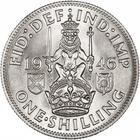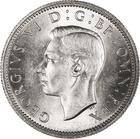The pre-decimal shilling (1s), also abbreviated in sums as e.g. 1/- for one shilling, was a unit of currency equalling one twentieth of a pound sterling, or twelve pence sterling; the "s" in the abbreviation is not from "shilling" but from "sestertius" - the Roman coin which was the ancestor of the denomination. It was used in the United Kingdom, and earlier in Great Britain and England.
The denomination had undergone several earlier changes: the King George III shilling (1816 - 1820), King George IV first issue (1821 only), King George IV second issue (1823 - 1825), King George IV third issue (1825 - 1829), the "wreath" type (1831 - 1887), a brief shield of the Coat of Arms (1887 - 1892), a "three shields" type (1893 - 1901), and then the English Lion on a crown (1902 - 1927).
In 1927, most denominations were re-designed by George Kruger Gray as part of the so-called "Fourth Coinage". The other denominations got new themes, but the shilling retained the general idea of the English Lion on top of St Edward's Crown; it was just re-designed to look more streamlined, and the crown is seen from a different aspect.
At the beginning of the reign of King George VI two Tudor roses were added and the earlier design was re-branded the "English Shilling", while this Scottish Shilling was introduced in parallel. It features a "Scottish" lion on top of the crown, a Scottish shield on the left and a thistle (the floral emblem of Scotland) on the right. Every year shillings of both types were issued in comparable mintages.
In 1953, the design was superseded by a new type of Scottish Shilling featuring the crowned Shield of Scotland.
The composition was 50% (0.0903 oz ASW) until 1946, after which time it was debased to copper-nickel together with the rest of the silver coinage. When the currency became decimal in 1971, shillings were re-denominated as five new pence; they remained legal tender until 1990, when a smaller type of five pence replaced them. | 





